Discover the enchanting world of best small indoor hanging plants and bring a touch of nature into your home. These space-saving wonders offer a plethora of benefits, from purifying the air to adding a splash of color and tranquility to any room.
Whether you’re a seasoned plant enthusiast or a novice gardener, this guide will provide you with all the essential information you need to create a thriving indoor oasis.
From delicate ferns to trailing succulents, our comprehensive list of small indoor hanging plants will inspire you with their diverse characteristics and ease of care. We’ll delve into the art of selecting the perfect hanging method, ensuring your plants thrive in their new aerial abodes.
Learn how to assess light levels and choose suitable plants accordingly, maximizing their growth and health.
Plant Varieties
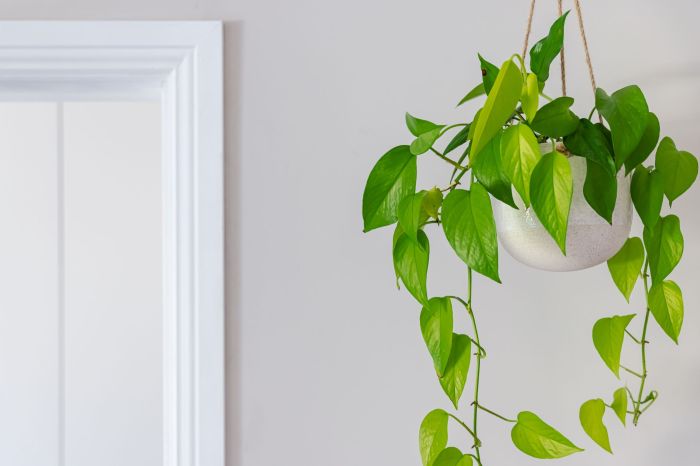
Small indoor hanging plants add a touch of greenery and freshness to any space. They are easy to care for and can thrive in a variety of conditions, making them a great choice for beginners and experienced plant enthusiasts alike.
Here are some of the most popular small indoor hanging plants, along with their unique characteristics and care tips:
Spider Plant
- Unique Characteristics:Long, trailing leaves with variegated stripes, produces baby plants (spiderettes) at the ends of its runners.
- Care Tips:Water when the soil feels dry to the touch, prefers bright indirect light but can tolerate low light conditions.
Pothos
- Unique Characteristics:Heart-shaped leaves with variegated patterns, trailing vines.
- Care Tips:Water when the top inch of soil feels dry, prefers bright indirect light but can tolerate low light conditions.
String of Pearls
- Unique Characteristics:Delicate, bead-like leaves that resemble strings of pearls, trailing stems.
- Care Tips:Water sparingly, allowing the soil to dry out completely between waterings, prefers bright indirect light.
Trailing Jade
- Unique Characteristics:Small, fleshy leaves that resemble jade, trailing stems.
- Care Tips:Water when the soil feels dry to the touch, prefers bright indirect light but can tolerate full sun.
Creeping Fig
- Unique Characteristics:Small, lobed leaves, trailing vines that can climb surfaces.
- Care Tips:Water when the top inch of soil feels dry, prefers bright indirect light but can tolerate low light conditions.
Wandering Jew
- Unique Characteristics:Colorful, variegated leaves with a trailing habit.
- Care Tips:Water when the top inch of soil feels dry, prefers bright indirect light but can tolerate low light conditions.
Hanging Options: Best Small Indoor Hanging Plants
Hanging plants is a great way to add greenery and life to your indoor space. There are a variety of ways to hang plants, so you can find a method that works best for your needs and decor. Here are a few of the most popular hanging options:
Macrame Hangers
Macrame hangers are a beautiful and bohemian way to hang plants. They are made from knotted cords, and they can be hung from the ceiling, a hook, or a curtain rod. Macrame hangers come in a variety of styles and colors, so you can find one that matches your decor.
Best small indoor hanging plants are an excellent way to add a touch of greenery to your home. These plants can be hung from the ceiling or placed on a shelf, and they can help to purify the air and add a sense of peace and tranquility to your space.
For more information on best house plants hanging, visit best house plants hanging . Whether you’re looking for a small plant to hang in your kitchen or a larger plant to add to your living room, there’s sure to be a best small indoor hanging plant that’s perfect for you.
Wire Baskets
Wire baskets are a simple and versatile way to hang plants. They can be hung from the ceiling, a hook, or a wall-mounted bracket. Wire baskets are available in a variety of sizes and shapes, so you can find one that is the right size for your plant.
Ceiling Hooks
Ceiling hooks are a great way to hang plants from the ceiling. They are easy to install, and they can be used to hang a variety of plants. Ceiling hooks are available in a variety of sizes and styles, so you can find one that matches your decor.
Small indoor hanging plants add a touch of greenery and freshness to any room. To display these plants effectively, consider using best indoor plant hangers . These hangers come in various styles and materials, allowing you to find the perfect fit for your decor and plant.
With the right hanger, you can showcase your small indoor hanging plants and create a beautiful, natural ambiance in your home.
DIY Hanging Planters
You can also make your own hanging planters using common materials. Here are a few ideas:
- Use a piece of driftwood to create a rustic hanging planter.
- Use a wire frame to create a geometric hanging planter.
- Use a piece of fabric to create a macrame hanging planter.
Creative Display Ideas
There are many creative ways to display hanging plants in your home. Here are a few ideas:
- Hang plants from the ceiling in a cluster to create a dramatic effect.
- Hang plants from a wall-mounted shelf to create a vertical garden.
- Hang plants from a curtain rod to create a privacy screen.
Plant Placement
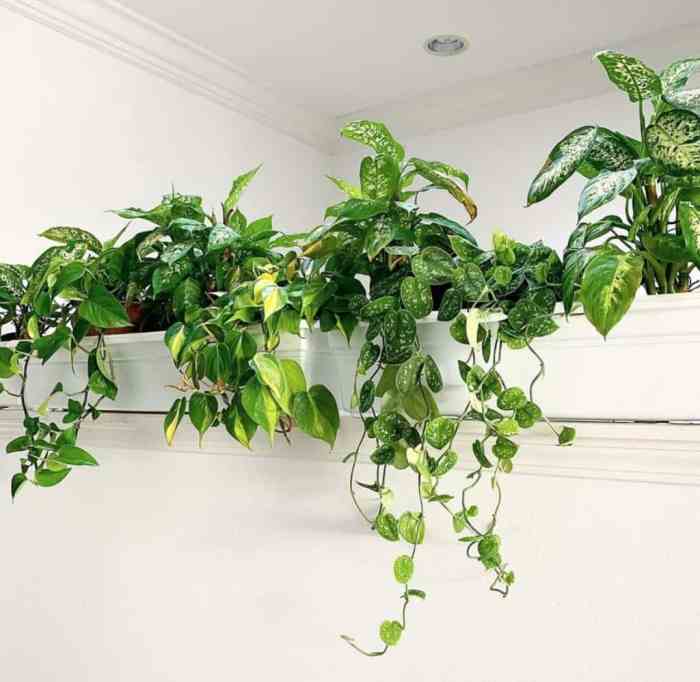
The placement of hanging plants is crucial for their health and growth. Different plant species have varying light requirements, so it’s essential to assess the light levels in a room before selecting suitable plants.
Light Conditions
- Bright, indirect light:Ideal for most hanging plants, such as ferns, philodendrons, and pothos. Place them near a window that receives plenty of natural light but not direct sunlight.
- Medium light:Suitable for plants that tolerate lower light levels, such as snake plants, ZZ plants, and spider plants. They can be placed a few feet away from a window or in a room with artificial light.
- Low light:Only a few hanging plants can tolerate low light conditions, such as peace lilies and cast iron plants. They should be placed in rooms with minimal natural light or supplemented with artificial light.
Maximizing Plant Growth
Proper placement can maximize plant growth and health. Here are some tips:
- Rotate plants regularly:This ensures even light distribution and prevents one side from becoming leggy.
- Avoid hanging plants too close to walls or other objects:This restricts airflow and can lead to pests or diseases.
- Consider the plant’s mature size:Choose a hanging pot that will accommodate the plant’s expected growth and prevent overcrowding.
Plant Care and Maintenance
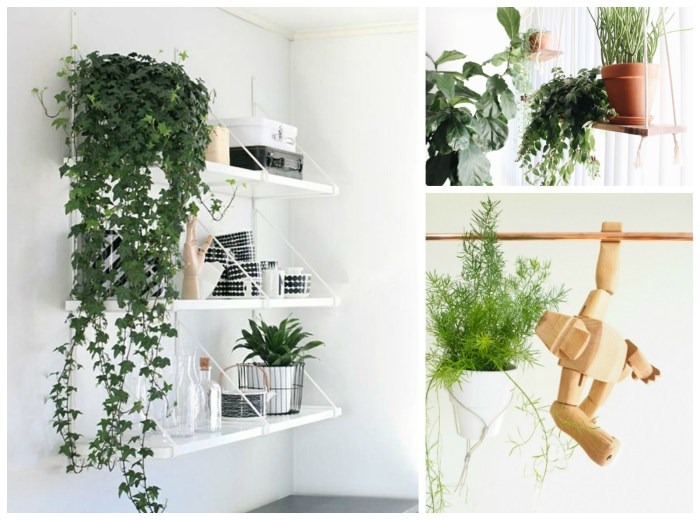
Maintaining the health and vitality of small indoor hanging plants requires regular care and attention. Understanding their specific needs and implementing appropriate practices can ensure their longevity and aesthetic appeal.
When it comes to the best small indoor hanging plants, there are a few things to consider. First, you’ll want to choose a plant that is relatively small and compact, so that it doesn’t take up too much space. Second, you’ll want to choose a plant that is relatively easy to care for, so that you don’t have to worry about it too much.
For more information on the best plants for hanging pots indoor, click here . Some of the best small indoor hanging plants include the spider plant, the pothos, and the peace lily.
Watering
Water is crucial for plant growth and should be provided when the soil feels slightly dry to the touch. Overwatering can lead to root rot, so it’s essential to avoid waterlogging. During the growing season, water more frequently, reducing it during the winter months.
Fertilizing
Fertilizing provides essential nutrients for plant growth. Choose a balanced fertilizer and apply it monthly during the growing season. Avoid over-fertilizing, as it can burn the roots.
Pruning, Best small indoor hanging plants
Regular pruning promotes healthy growth and prevents legginess. Remove dead or damaged leaves and stems, and trim back overgrown plants to encourage new growth.
Common Problems
Indoor hanging plants can face various challenges, including pests, diseases, and nutrient deficiencies. Early detection and treatment are key to maintaining their health.
Pests
- Aphids: Small, green or black insects that feed on plant sap.
- Spider mites: Tiny, spider-like creatures that cause yellowing and stippling of leaves.
To control pests, use insecticidal soap or neem oil.
Diseases
- Powdery mildew: A white, powdery substance on leaves caused by a fungus.
- Botrytis: A gray mold that affects stems and flowers.
For disease prevention, ensure proper air circulation and avoid overwatering. If disease occurs, remove infected leaves and treat with a fungicide.
Nutrient Deficiencies
- Nitrogen deficiency: Yellowing leaves and stunted growth.
- Potassium deficiency: Brown leaf tips and edges.
Address nutrient deficiencies by fertilizing regularly and using a balanced fertilizer.
Aesthetic Considerations
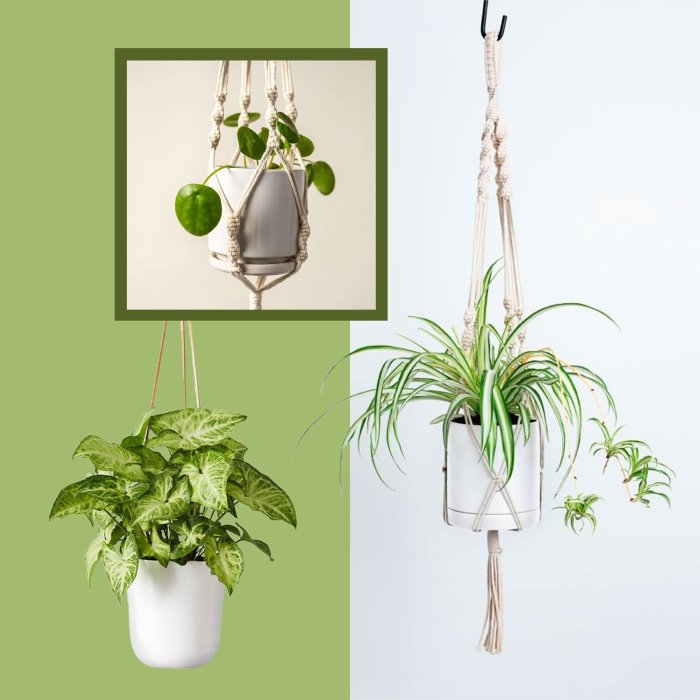
Integrating hanging plants into interior design can elevate the aesthetic appeal of a room. When selecting plants, consider their compatibility with the existing decor style. Lush, trailing plants complement bohemian and eclectic spaces, while structured plants with upright growth habits suit modern and minimalist interiors.
Hanging plants can serve as focal points, drawing attention to a specific area of the room. They can also be used as accents, adding a touch of greenery and freshness to corners or empty spaces. The visual impact of hanging plants can be enhanced by grouping them in clusters or suspending them at varying heights, creating a dynamic and layered effect.
Complementary Styles
- Bohemian:Trailing plants like pothos, philodendron, and spider plants add a touch of wildness and bohemian flair.
- Modern:Structured plants like snake plants, ZZ plants, and air plants bring a clean and contemporary aesthetic.
- Scandinavian:Minimalist plants like string of pearls, succulents, and ferns complement the simplicity and functionality of Scandinavian design.
- Industrial:Plants with a more industrial look, such as air plants in metal holders or hanging terrariums, add an edgy touch.
Final Conclusion
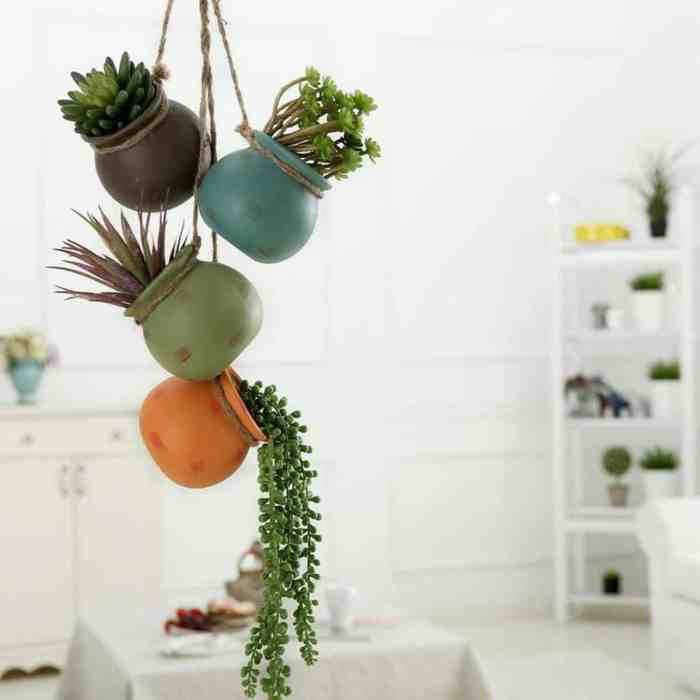
With proper care and maintenance, your small indoor hanging plants will flourish, adding a touch of beauty and serenity to your living space. Embrace the joy of nurturing these enchanting companions and witness the transformative power they bring to your home.
Let the symphony of nature fill your abode, creating a harmonious and inviting atmosphere that will uplift your spirits and inspire a sense of well-being.
FAQ Insights
How often should I water my hanging plants?
The frequency of watering depends on the type of plant and the environment. Generally, water when the soil feels dry to the touch.
What are some common problems with hanging plants?
Common problems include underwatering, overwatering, pests, and nutrient deficiencies. Regular care and monitoring can prevent most issues.
Can hanging plants purify the air?
Yes, many hanging plants have air-purifying qualities. Some effective options include spider plants, peace lilies, and ferns.